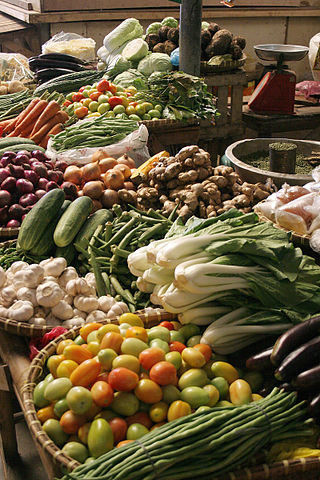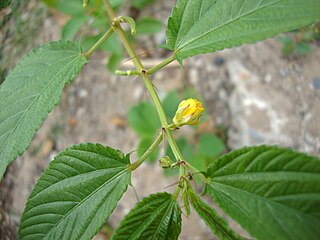Related Research Articles

Spinach is a leafy green flowering plant native to central and Western Asia. It is of the order Caryophyllales, family Amaranthaceae, subfamily Chenopodioideae. Its leaves are a common edible vegetable consumed either fresh, or after storage using preservation techniques by canning, freezing, or dehydration. It may be eaten cooked or raw, and the taste differs considerably; the high oxalate content may be reduced by steaming.

Mycoprotein, also known as mycelium-based protein or fungal protein, is a form of single-cell protein derived from fungi for human consumption.

Chard or Swiss chard is a green leafy vegetable. In the cultivars of the Flavescens Group, the leaf stalks are large and often prepared separately from the leaf blade; the Cicla Group is the leafy spinach beet. The leaf blade can be green or reddish; the leaf stalks are usually white, yellow or red.
A mycotoxin is a toxic secondary metabolite produced by fungi and is capable of causing disease and death in both humans and other animals. The term 'mycotoxin' is usually reserved for the toxic chemical products produced by fungi that readily colonize crops.

Fusarium is a large genus of filamentous fungi, part of a group often referred to as hyphomycetes, widely distributed in soil and associated with plants. Most species are harmless saprobes, and are relatively abundant members of the soil microbial community. Some species produce mycotoxins in cereal crops that can affect human and animal health if they enter the food chain. The main toxins produced by these Fusarium species are fumonisins and trichothecenes. Despite most species apparently being harmless, some Fusarium species and subspecific groups are among the most important fungal pathogens of plants and animals.

Leaf vegetables, also called leafy greens, pot herbs, vegetable greens, or simply greens, are plant leaves eaten as a vegetable, sometimes accompanied by tender petioles and shoots. Leaf vegetables eaten raw in a salad can be called salad greens.

Wheatgrass is the freshly sprouted first leaves of the common wheat plant, used as a food, drink, or dietary supplement. Wheatgrass is served freeze dried or fresh, and so it differs from wheat malt, which is convectively dried. Wheatgrass is allowed to grow longer and taller than wheat malt.
African cuisine is an integral part of the continent's diverse cultures reflecting its long and complex history. The evolution of African cuisine is closely entwined with the lives of the native people, influenced by their religious practices, climate and local agriculture. Early African societies were largely composed of hunter-gatherers who relied on foraging for wild fruits, vegetables, nuts, and hunting animals for sustenance. As agriculture developed across the continent, there was a gradual shift to a more settled lifestyle with the cultivation of crops such as millet, sorghum, and later maize. Agriculture also brought about a change in diet, leading to the development of a variety of culinary traditions which vary by religion. Many African traditional dishes are based on plant- and seed-based diets.

Ugali, also known as posho, nsima, papa, pap, sadza, isitshwala, akume, amawe, ewokple, akple, and other names, is a type of corn meal made from maize or corn flour in several African countries: Kenya, Uganda, Tanzania, Zimbabwe, Zambia, Lesotho, Eswatini, Angola, Mozambique, Namibia, Democratic Republic of the Congo, Malawi, Botswana and South Africa, and in West Africa by the Ewes of Togo, Ghana, Benin, Nigeria and Cote D'Ivoire. It is cooked in boiling water or milk until it reaches a stiff or firm dough-like consistency. In 2017, the dish was added to the UNESCO Representative List of the Intangible Cultural Heritage of Humanity, one of a few foods in the list.

The cuisine of Botswana is unique but shares some characteristics with other cuisines of Southern Africa. Examples of Setswana food include pap, samp, magwinya, bogobe and mophane worms. A food unique to Botswana is seswaa, salted mashed-up meat.

Vegetables are parts of plants that are consumed by humans or other animals as food. The original meaning is still commonly used and is applied to plants collectively to refer to all edible plant matter, including the flowers, fruits, stems, leaves, roots, and seeds. An alternative definition of the term is applied somewhat arbitrarily, often by culinary and cultural tradition. It may exclude foods derived from some plants that are fruits, flowers, nuts, and cereal grains, but include savoury fruits such as tomatoes and courgettes, flowers such as broccoli, and seeds such as pulses.

Abelmoschus manihot, commonly known as aibika, is a flowering plant in the family Malvaceae. It is a tropical subshrub or shrub native to the Indian subcontinent, Indochina, central and southern China, Malesia, New Guinea, and Queensland. It is cultivated and eaten as a leaf vegetable, among other uses. It was previously classified as a species of Hibiscus but is now categorized under the genus Abelmoschus. This plant is also referred to as the sunset muskmallow, sunset hibiscus, or hibiscus manihot.

Breynia androgyna, also known as katuk, star gooseberry, or sweet leaf, is a shrub grown in some tropical regions as a leaf vegetable. Its multiple upright stems can reach heights of 2.5 meters and bear dark green oval leaves of length 5–6 centimetres.

Jute mallow or Jew's mallow or Nalita jute is a species of shrub in the family Malvaceae. Together with C. capsularis it is the primary source of jute fiber. The leaves and young fruits are used as a vegetable, the dried leaves are used for tea and as a soup thickener, and the seeds are edible.
Fusarium sporotrichioides is a fungal plant pathogen, one of various Fusarium species responsible for damaging crops, in particular causing a condition known as Fusarium head blight in wheat, consequently being of notable agricultural and economic importance. The species is ecologically widespread, being found across tropical and temperate regions, and is a significant producer of mycotoxins, particularly trichothecenes. Although mainly infecting crops, F. sporotrichioides-derived mycotoxins can have repercussions for human health in the case of the ingestion of infected cereals. One such example includes the outbreak of alimentary toxic aleukia (ATA) in Russia, of which F. sporotrichioides-infected crop was suspected to be the cause. Although current studies on F. sporotrichioides are somewhat limited in comparison to other species in the genus, Fusarium sporotrichioides has found several applications as a model system for experimentation in molecular biology.

Fijian cuisine has long consisted of primarily foraged and farm-grown food. Although rice, wheat, and tea all became staples during Fiji's colonial era, native Fijians still eat primarily tubers and coconuts. The cuisine of Fiji is known for its seafood and various green vegetables, including ''ota'', a young forest fern, and ''bele'', a plant that resembles spinach.

Maize, also known as corn in North American English, is a tall stout grass that produces cereal grain. It was domesticated by indigenous peoples in southern Mexico about 9,000 years ago from wild teosinte. Native Americans planted it alongside beans and squashes in the Three Sisters polyculture. The leafy stalk of the plant gives rise to male inflorescences or tassels which produce pollen, and female inflorescences called ears. The ears yield grain, known as kernels or seeds. In modern commercial varieties, these are usually yellow or white; other varieties can be of many colors.

African nightshades are several species of plants in the section Solanum of the genus Solanum, that are commonly consumed as leafy vegetables and herbs. African nightshades are grown in both high and lowland areas in West and East Africa, particularly in Nigeria and Cameroon.The Nso people call it Nyuuseji, and the Kom people call it Mbasi. There is a large variation in diversity of the African nightshades, which have many nutritional and medicinal benefits, even though the family of nightshade is commonly known as comprising dangerous weeds or poisonous plants. Species known as African nightshade include Solanum scabrum, Solanum villosum, Solanum nigrum, and Solanum americanum. Other common names for African nightshade are Black nightshade and Narrow-leaved nightshade. Local names of African nightshade include managu (Kikuyu), mnavu (Swahili), rinagu (Kisii), tsisutsa (Luhya), osuga (Luo), isoiyot (Kipsigis), kitulu (Kamba), ormomoi (Maa), ndunda (Taita), nsugga (Luganda), sochot (Keiyo), and esisogho (Lukhonzo).

A staple food, food staple, or simply staple, is a food that is eaten often and in such quantities that it constitutes a dominant portion of a standard diet for an individual or a population group, supplying a large fraction of energy needs and generally forming a significant proportion of the intake of other nutrients as well. For humans, a staple food of a specific society may be eaten as often as every day or every meal, and most people live on a diet based on just a small variety of food staples. Specific staples vary from place to place, but typically are inexpensive or readily available foods that supply one or more of the macronutrients and micronutrients needed for survival and health: carbohydrates, proteins, fats, minerals, and vitamins. Typical examples include grains, seeds, nuts and root vegetables. Among them, cereals, legumes and tubers account for about 90% of the world's food calorie intake.

Mary Oyiela Abukutsa-Onyango is a humanitarian and agricultural scientist from Kenya who specializes in olericulture, agronomy, plant physiology. Abukutsa-Onyango is a professor of horticulture at Jomo Kenyatta University of Agriculture and Technology whose work focuses on African indigenous food crops. Abukutsa Onyango has studied how African indigenous vegetables can be used to combat malnutrition in Africa while maintaining a secure form of revenue even during more challenging weather and climate.
References
- "Astronomic gastronomic menu for big bash". Independent Online. Retrieved 6 August 2008.
- "How healthy is traditional morogo in Africa". Science in Africa. Archived from the original on 25 September 2008. Retrieved 6 August 2008.
- "Linolenic acid and folate in wild-growing African dark leafy vegetables (morogo)". Public Health Nutrition, Cambridge University Press. Retrieved 6 August 2008.
- "The occurrence of toxogenic moulds in traditional household Morogo of Giyana" (PDF). North-West University Library. Retrieved 6 August 2008.[ dead link ]
- "The level of mycotic and mycotoxigenic Fusaria in traditional morogo and the agro-environment of Dikgale Demographic Surveillance Site" (PDF). North-West University Library. Retrieved 6 August 2008.[ dead link ]
- "Conservation and utilization of indigenous vegetables in Botswana". Bioversity International. Archived from the original on 3 May 2008. Retrieved 6 August 2008.